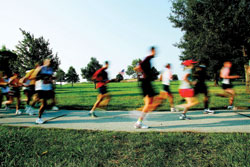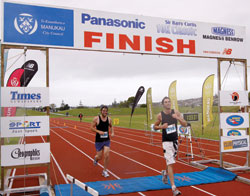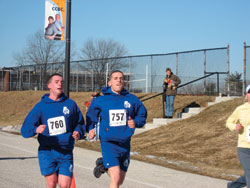
 He didn't have sweat-wicking clothing. He didn't have a personal trainer. He most assuredly didn't have ergonomically correct running shoes. And yet the good old Greek soldier-turned messenger-turned-legend Pheidippes ran all the way to Athens from the Battle of Marathon to bring news of the outcome of that fight. Pretty impressive guy, Pheidippides, even if, according to the stories, he dropped dead after delivering his message.
He didn't have sweat-wicking clothing. He didn't have a personal trainer. He most assuredly didn't have ergonomically correct running shoes. And yet the good old Greek soldier-turned messenger-turned-legend Pheidippes ran all the way to Athens from the Battle of Marathon to bring news of the outcome of that fight. Pretty impressive guy, Pheidippides, even if, according to the stories, he dropped dead after delivering his message.
Even though historians are still arguing whether there was a Pheidippides, or whether he did make a legendarily long run without stopping, there's no doubt that the competitive foot race as we know it is one of the oldest disciplines in sports. After all, the ancient Greeks were staging contests in running (and jumping and throwing) long before beach volleyball and figure skating came to be.
While the marathon (a total of 26.2 miles) may be one of the first competitive road racing events that comes to mind, it's far from the only kind staged each year. There are races of shorter distances (including those of five kilometers (or 5Ks, in the language of the running community), 10Ks and so forth) as well as 10-milers, half-marathons and more. (A niche segment of the running community gravitates toward extreme distances, such as ultra-marathons; another goes for multi-sport events, such as triathlons).
As the planner of a running event, your goal is the same as that of your athletes: to be a winner. But while your athletes will consider the gun going off to be the start of the race, your start is much earlier.
Getting on course Decide what you want: an urban route? A run through the suburbs? A course that winds through areas of scenic, historic or other significance? Depending upon the length of your race, the time of day and your chosen location, you may have some nice selections. Find out what is in the area that makes it interesting. With the advent of the Internet, runners have the ability to find out about any number of races.
Decide what you want: an urban route? A run through the suburbs? A course that winds through areas of scenic, historic or other significance? Depending upon the length of your race, the time of day and your chosen location, you may have some nice selections. Find out what is in the area that makes it interesting. With the advent of the Internet, runners have the ability to find out about any number of races.
"If you're going to do a 5K, you better have an interesting hook," says Lee Corrigan, president of the Maryland-based event management company, Corrigan Sports, which puts on the Baltimore Marathon. "There are five 5Ks every weekend, so you want yours to be a little different."
Is it certified?
If this a competition at which records may be set, a planner should find out whether the course is certified, which is to say, professionally measured and recorded as being in compliance with the standards of the applicable governing body. The governing body for open competition in the U.S. is USA Track and Field (USATF). This means that a 5K race, for example, has to be professionally measured by a representative of the USATF and certified as being five kilometers long.
 The certification process can vary according to the complexity of the route and the schedule of the professional who will be doing certification work. According to Jim Estes, associate director of marketing and long distance running at USATF, planners generally charge by the mile or kilometer of the course, although there are exceptions to this. Estes also notes that planners need to build in the time not just for course certification but for permitting and other approval.
The certification process can vary according to the complexity of the route and the schedule of the professional who will be doing certification work. According to Jim Estes, associate director of marketing and long distance running at USATF, planners generally charge by the mile or kilometer of the course, although there are exceptions to this. Estes also notes that planners need to build in the time not just for course certification but for permitting and other approval.
"Most people who want to host a race don't realize that you can't just show up and put up barricades," Estes notes. "There's a lot more that goes into it."
Build permitting costs into your budget, along with costs for officials' time (meaning police or others). You may need to rent traffic cones, barricades and more.
A manageable event?
Depending upon the size and complexity of your event, the level of competition you're expecting, and your familiarity with putting on a road race, you may wish to consider hiring professional logistical management. A professional race management company can help you select a certified course (or have one certified), market your event, design and print T-shirts, sports bags, etc., coordinate staff and volunteers, operate all start and finish line equipment and generate lists of finishers.
 "We've found that a lot of groups turn to us, or really, to any professional company, because we've done things in the area before," says Kelly Dees of Charm City Run, located in Baltimore. "A professional company has a timeline to work with, connections with authorities and so on. We've seen that, for example, nonprofits might be very sure of the fund raising piece but what they need help with is the race planning process and the logistics."
"We've found that a lot of groups turn to us, or really, to any professional company, because we've done things in the area before," says Kelly Dees of Charm City Run, located in Baltimore. "A professional company has a timeline to work with, connections with authorities and so on. We've seen that, for example, nonprofits might be very sure of the fund raising piece but what they need help with is the race planning process and the logistics."
You can control many aspects of your event, but at the last minute, there can be problems that need to be dealt with. Weather, for example, can be a game-changer and can wreak havoc.
Staying on course
Sam Fisher of Fisher Tracks in Boone, Iowa, says that race courses should be set up for good flow. When the race first goes off, for example, the pack should be able to surge forward and not encounter any obstacles.
"Avoid corners immediately after the starting gun," says Fisher. "The longer straightway you can have, the more the group can thin out a little bit to navigate the corners without people getting cut off, shoes being stepped on, and elbows flying into other runners."
Starting small, growing bigger Ron Nemeth, a retired track builder and meet official now based in New Port Richey, Florida, recommends growing an event through the years rather than starting with a blockbuster-sized race.
Ron Nemeth, a retired track builder and meet official now based in New Port Richey, Florida, recommends growing an event through the years rather than starting with a blockbuster-sized race.
"A well planned and executed small race will bring runners back next year and of course it can always grow from there. The planning is the most important part. What goes on behind the scenes is key to its success of any event."
To plan a successful event, you'll need to make arrangements for...
Parking for spectators, transportation if it's a point-to-point race.
Spectators: A large event or a marathon may require barricades to keep spectators from interfering with the race.
Seeding: Particularly in larger events, race officials may 'seed' racers; that is, place faster or professional athletes closer at the start line, and other racers further back.
Athletes in Wheelchairs: Many race officials hold a separate wheelchair start five minutes early so as to avoid accidents or congestion with racers on foot. Check your insurance coverage and ascertain that no other special arrangements need to be made. You will need to make sure parking, as well as rest rooms and other facilities are handicap-accessible.
Traffic Control: Police support may be necessary
Conveniences: Portable toilets and hand sanitizing stations, water stops and more
Course Marshals: At every turn of your race (literally), you need staff members or volunteers to point runners in the correct direction
Awards for top finishers
Race Amenities: Time clocks, mile markers, finish arches, sag wagons, chip timers, etc.
Emergency Facilities: Trained personnel should maintain a presence in case runners become injured or ill
Safety Rules: Many races have prohibit dogs, strollers, skates, bikes and the use of headphones on the course.

